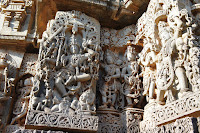So... I had a fish bone stuck in my throat for nearly a week, and it got so bad that I finally decided to go see a doctor (yep, I am not so fond of hospitals). First, I tried a doc near our house that my great neighbor Leela introduced me to. The doc was professional yet old and didn't have any kind of new-and-high-tech-looking devices in his small office. He looked into my throat with his antique-looking head scope (and with his reading glasses on??) but couldn't find anything, so he recommended I go to a bigger hospital. Yes, yes, so off I went to Manipal Hospital near the old airport.
The hospital was packed with people as usual. But something was so different from the typical hospital ambiance. You know how hospitals are usually white, white, and white with blue or green clothed workers and occasionally colored clothed visitors. The minute I stepped in, all kinds of color came into my vision. Bright! Lots of bright saris all over the place. That somewhat added warmth to the typically cold feeling of hospitals that I hate.
Since this was my first time there, I had to go through registration. It was pretty organized, to my surprise. An old man (probably a retired volunteer?) was at the main reception area and guided me how to do the registration. I filled out a piece of paper with my name, address, passport #, etc, and went back to the reception desk where three ladies were behind the counter typing in what the people filled out in their registration forms. On the counter, there was a monitor facing towards the patient, so they can check what the lady behind the counter is typing. This is good, as you can catch any errors she may be making, such as in my case when she typed "India" as my birth place. So I immediately raised a red flag and said "no, no, do I look Indian?" She looked up only with her eyes, smiled, nodded, and immediately fixed the entry. Efficient!
The old man told me that the ENT is on the 1st floor (meaning 2nd floor in the US) and that I need to register there again. He was very helpful. The ENT section was also crowded. I had called earlier to make an appointment, so they were expecting me. I got there 15 mins earlier than my appointment, so they told me to just wait. I waited for an hour (45 mins or so past my appointment) and finally my name-like name was called. They called me differently, but I figured such a weird name had to be mine :-)
Guessing from his height (tall!), the doctor might have been from the north. He had something comical about him. He wore a friendly smile somewhere on his face (couldn't really pin down which part of his face) all the time. When I explained what I think might have happened and told him that the other OLD doctor couldn't find a bone, he giggled and told me "let's see if this younger doctor could find it". Everyone laughed. However, he could not find it, either. So, he decided to go with the endoscope. Ouch! That was the one thing I had hoped to avoid, as I've had one before in the US and it was really uncomfortable. Yet I was so eager to get rid of the bone that I went for it of course.
One of the nurses took me to another room that had some spiffy looking new devices and equipment which calmed me down somehow (yes, strange certain objects can calm people down) and started to numb my nostrils and throat. After waiting for 15 mins, my throat was still sore (I also had some cold...), I asked for more numbing spray (yep... call me a weakling). After waiting for another 10 mins, the same doctor came and started to put an endoscope into my throat through my nose. It tickled but didn't hurt like last time. Okay, this isn't bad. I could still feel the endoscope going up and down and knew he found something when I heard the sucking sound. It took less than 3 mins. I got up, and there they were - four pictures of my throat on the monitor in front of me. One of the eight nurses tightly squeezed into the room to watch the doctor's fabulous work explained to me in detail what the four pictures were and how they could see a small white object next to my esophagus in one picture and how that was removed in the second picture. Indeed, there was something stuck in the corner of my throat, and now it was GONE!
The doc asked me how I felt, but all I could say was that I was numb. Sorry doc! All of them laughed :) Although my throat is still sore due to my cold probably, I no longer have that strange feeling in my throat. Thank you doc! You were great.

















































